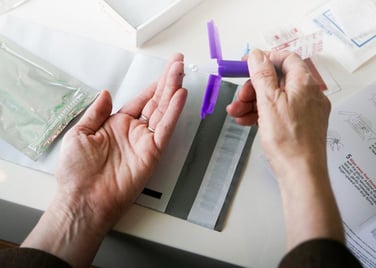Share this
5 tips for expediting clinical trial recruitment
by Neoteryx Microsampling on Mar 25, 2020 7:00:00 AM

Recruitment and retention of volunteers for cancer-related clinical trial programs are particularly worrisome. Fewer than 5% of cancer patients participate in trials.
According to the National Cancer Institute, if 10% of oncology patients participated in studies, the trials would be completed within a year instead of the usual 3-5 years.
A study about attitudes and motivating factors behind reduced patient enrollment rates shows challenges in recruitment and retention of clinical trial subjects are a result of 3 main factors:
1. Subject-related barriers – These barriers relate to the participant’s view about the research. Subjects often feel like “guinea pigs” during the experiments. Additionally, participants may reject the research due to lack of support from family and friends.
2. Protocol Barriers – The design of the study can also hinder patient recruitment. Too many visits, invasive testing, or too many complicated procedures, for example, can discourage subjects from completing the trials. There is also the issue of some protocols following strict eligibility criteria that excludes the majority of subjects.
Clinical trials that take a long time may also affect a participant’s willingness to enroll in the study. For example, studies that last 5-10 years may experience little or no enrollment as few people are willing to commit to that time.
3. Investigator-related Challenges –These challenges relate to the researchers’ perception about the trial, their ability to communicate, and their faith in the research. Investigators are not always able to explain the proposed study in a way that encourages subjects to participate. Time constraints and schedule conflicts can also deter investigators from dedicating the necessary time toward recruiting potential candidates. In short, they may have poor patient recruitment strategies.
Additional factors or barriers to recruiting for clinical trials may include the high costs or budgetary constraints.
5 Ways to Improve Clinical Trial Recruitment
1. Improve Patient Screening Methods
When a patient is identified, the research organization should have an effective screening process that isn't disruptive and/or requires little travel.
-1-1.jpeg?width=377&height=258&name=collection-Mitra-anywhere-car%20(2)-1-1.jpeg) If blood testing is part of the screening process, it is important to make this as convenient and comfortable as possible. Technologies such as remote sampling have made mobile or portable approaches to such processes possible.
If blood testing is part of the screening process, it is important to make this as convenient and comfortable as possible. Technologies such as remote sampling have made mobile or portable approaches to such processes possible.
With remote microsampling, clinical trial candidates can submit samples from wherever they are and at any time without visiting the research facility or trial site. Minimal training is required for finger-stick sample collection using remote tools such as the Mitra® device.
 These devices can be shipped to study candidates or participants at home in kits, which eliminates the need for professionals traveling in mobile units to perform the screening process. Related candidate screening activities can be conducted online, using secure digital portals dedicated to the study.
These devices can be shipped to study candidates or participants at home in kits, which eliminates the need for professionals traveling in mobile units to perform the screening process. Related candidate screening activities can be conducted online, using secure digital portals dedicated to the study.
2. Develop a Patient-Centered Recruitment Process
Stakeholders are increasingly shifting efforts to more patient-centered approaches when planning and executing recruitment strategies. The need is to plan recruitment strategies based on patients needs, not the disease. Specific patient recruitment strategies in clinical trial design process involve researchers partnering with patients in a bid to generate active involvement in:
- Collecting feedback from patients about the study design
- Determining how to effectively engage patients, peers, and communities as volunteers in the trials
- Providing feedback about clinical processes
- Setting research agendas
Such efforts foster patients’ sense of ownership in the drug development process as pharmaceutical companies shift focus to developing personalized and patient-centric medicine.
3. Use Interactive Aids to Encourage Enrollment
Lack of appropriate information is another obstacle preventing people from enrolling in clinical trials. A review conducted in 2013 to determine the effect of modifying trial information and how it is delivered influenced the enrollment rate:
A comparison of written, audiovisual and video materials showed subjects were more willing to participate in the trials if the information was presented using videos. Also, interactive computer presentations or web pages as resources that offered both videos and illustrated instructions improved recruitment compared to simply an audiotaped display.
4. Leverage Mobile Platforms and Social Media
How patients or others learn about clinical trials has changed over the years. Previously, patients learned about trials via mail, the media, and their own healthcare providers. In the early 2000s, there was a significant shift in how the organizations solicited potential candidates.
The contract research organizations (CROs) working with pharmaceutical companies no longer needed to rely on the healthcare provider's word of mouth to patients or on “snail-mail” promotions to their mailing lists. Digital communication channels (email, etc.) had become more sophisticated and were being utilized for recruitment.
Today communication is much more direct, thanks to smartphones and the use of social media platforms. One study revealed social media platforms like Facebook have great potential when it comes to recruiting individuals for clinical trials.
5. Implement Systems to Monitor and Follow-Up with Patients
After patients have enrolled in a study, the research organization, CRO or pharmaceutical trial sponsor should implement ways to follow-up with the patient recruits to ensure they stay engaged, which can help improve the study retention rate.
Again, remote blood microsampling can play a critical role in study retention. The researchers can remotely monitor patients’ responses to new drugs using microsampling devices that enable them to self-collect samples at home and mail them directly to the lab for analysis.
Learn more about remote microsampling to improve clinical trial recruitment and retention by visiting our resource page, Microsampling for Decentralized Clinical Trials:
Image credits: Trajan, Neoteryx, iStock
Share this
- Microsampling (206)
- Research, Remote Research (119)
- Venipuncture Alternative (106)
- Clinical Trials, Clinical Research (83)
- Mitra® Device (73)
- Therapeutic Drug Monitoring, TDM (51)
- Dried Blood Spot, DBS (39)
- Biomonitoring, Health, Wellness (30)
- Infectious Disease, Vaccines, COVID-19 (24)
- Blood Microsampling, Serology (23)
- Omics, Multi-Omics (21)
- Decentralized Clinical Trial (DCT) (20)
- Specimen Collection (18)
- Toxicology, Doping, Drug/Alcohol Monitoring, PEth (17)
- Skin Microsampling, Microbiopsy (13)
- hemaPEN® Device (13)
- Preclinical Research, Animal Studies (12)
- Pharmaceuticals, Drug Development (9)
- Harpera Device (6)
- Industry News, Microsampling News (5)
- Antibodies, MAbs (3)
- Company Press Release, Product Press Release (3)
- Environmental Toxins, Exposures (1)
- May 2025 (1)
- April 2025 (2)
- December 2024 (2)
- November 2024 (1)
- October 2024 (3)
- September 2024 (1)
- June 2024 (1)
- May 2024 (1)
- April 2024 (4)
- March 2024 (1)
- February 2024 (2)
- January 2024 (4)
- December 2023 (3)
- November 2023 (3)
- October 2023 (3)
- September 2023 (3)
- July 2023 (3)
- June 2023 (2)
- April 2023 (2)
- March 2023 (2)
- February 2023 (2)
- January 2023 (3)
- December 2022 (2)
- November 2022 (3)
- October 2022 (4)
- September 2022 (3)
- August 2022 (5)
- July 2022 (2)
- June 2022 (2)
- May 2022 (4)
- April 2022 (3)
- March 2022 (3)
- February 2022 (4)
- January 2022 (5)
- December 2021 (3)
- November 2021 (5)
- October 2021 (3)
- September 2021 (3)
- August 2021 (4)
- July 2021 (4)
- June 2021 (4)
- May 2021 (4)
- April 2021 (3)
- March 2021 (5)
- February 2021 (4)
- January 2021 (4)
- December 2020 (3)
- November 2020 (5)
- October 2020 (4)
- September 2020 (3)
- August 2020 (3)
- July 2020 (6)
- June 2020 (4)
- May 2020 (4)
- April 2020 (3)
- March 2020 (6)
- February 2020 (3)
- January 2020 (4)
- December 2019 (5)
- November 2019 (4)
- October 2019 (2)
- September 2019 (4)
- August 2019 (4)
- July 2019 (3)
- June 2019 (7)
- May 2019 (6)
- April 2019 (5)
- March 2019 (6)
- February 2019 (5)
- January 2019 (8)
- December 2018 (3)
- November 2018 (4)
- October 2018 (7)
- September 2018 (6)
- August 2018 (5)
- July 2018 (8)
- June 2018 (6)
- May 2018 (5)
- April 2018 (6)
- March 2018 (4)
- February 2018 (6)
- January 2018 (4)
- December 2017 (2)
- November 2017 (3)
- October 2017 (2)
- September 2017 (4)
- August 2017 (2)
- July 2017 (4)
- June 2017 (5)
- May 2017 (6)
- April 2017 (6)
- March 2017 (5)
- February 2017 (4)
- January 2017 (1)
- July 2016 (3)
- May 2016 (1)
- April 2016 (2)



No Comments Yet
Let us know what you think